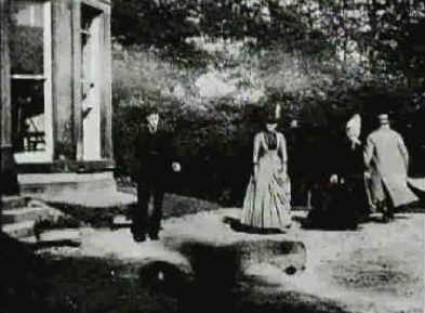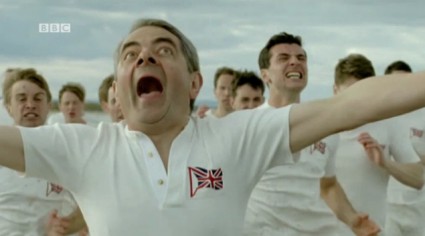Roundhay Garden Scene
Years ago, when I first discovered films, and I started to absorb all the information that I could from guides and reference books, I came across the Sight and Sound ten-yearly lists of the greatest films ever made, as voted for by an august group of film critics. There was a sense of awe at titles I had yet to see, such as Citizen Kane, Bicycles Thieves, Ugetsu Monogatari or Battleship Potemkin, and fascination at how changing tastes brought new films into favour and old certainties fall away with each decade’s new choices.
In 1982 I eagerly devoured what was the fourth to be held, where Citizen Kane retained its top place (I had seen it by then and respected it deeply), followed by La Règle du jeu, Seven Samurai, Singin’ in the Rain, and so on. I naturally thought of what my own top ten would be and wondered if anyone would ever seek out my opinion – unlikely since I had neither the ambition or ability to be a film critic.
But time moves on in strange ways, and Sight and Sound has tried to widen its net to get away from the choices of an elite, til by 2012 they invited a thousand people who write about or work with film, not just in books, the newspapers and film journals but on blogs and other online outlets. And so it was that the email came through, with these words:
I would like to invite you to take part in the 2012 poll. We realise that this is not the easiest of tasks, but we want you to know that this is a major worldwide endeavour that will help us all to remind people of film’s rich history and to refine what we mean by the best of cinema.
Please draw up a list of ten films only, in order of preference or, if you’d rather, alphabetically. The order does not matter to the voting system – we will allot one vote only to each of your ten films. We also invite you to add a short commentary after the list explaining why you have chosen the films in your top ten.
As for what we mean by ‘Greatest’, we leave that open to your
interpretation. You might choose the ten films you feel are most important to film history, or the ten that represent the aesthetic pinnacles of achievement, or indeed the ten films that have had the biggest impact on your own view of cinema.
But how sad, because after thirty odd years of following films closely, I no longer had much belief on interest in ‘best’ films nor that much interest in film as art. But I wasn’t going to say no. So I wrote back with my ‘top ten’ (in chronological order) with an afterword that said what I thought about the whole process. Here’s what I wrote:
- Roundhay Garden Scene (Louis Augustin Aimé Le Prince, 1888)
- Le village de Namo – Panorama pris d’une chaise à porteurs (Gabriel Veyre, 1900)
- The Big Swallow (James Williamson, 1901)
- L’aveugle de Jérusalem (Louis Feuillade, 1909)
- The Battle of the Somme (J.B. McDowell, Geoffrey Malins, 1916)
- The Lady of the Dugout (W.S. Van Dyke, 1918)
- Spare Time (Humphrey Jennings, 1939)
- Free Radicals (Len Lye, 1958)
- Topsy-Turvy (Mike Leigh, 1999)
- Me at the Zoo (Yakov Lapitsky, 2005)
I no longer know what makes a great film, nor how a film can stay great, since so many that I once revered have dulled through familiarity, while others previously spurned when seen again startle with unexpected brilliance. The films I have chosen are not so much the ‘best’ as films that I could not imagine being done any better. Each is innovatory in its own way, which may explain the bias towards early films – all the good ideas were fresh then. The earliest title in my selection is a motion picture older than film itself, ushering in a new way of seeing the world. The newest is the first title to appear on YouTube, the symbolic moment when the medium reinvented itself beyond ‘film’.
Le Prince’s 1888 record of his family playing around in their garden does indeed precede the medium of film (it was shot on photo-sensitised paper). It seems to me to do what the moving image does best, at the very beginnings of what came to be called film. The film by Lumière cameraman Gabriel Veyre is a breathtaking reverse tracking shot taken in a Vietnamese village in 1900 (you can see in on the Gabriel Veyre website) – a superb demonstration of documentary imagination. The Big Swallow is film’s wittiest comment on itself, in which the irate subject of a film swallows the cameraman. L’aveugle de Jérusalem, an imaginary parable, is an obscure choice, though Feuillade is a celebrated enough name. But for me it is the perfectly constructed one-reeler, which I have praised here before now.
The documentary The Battle of the Somme made a greater social impact in its day than probably any film since (in Britain at least) and though more shocking films of war have been made since, as I wrote in my review of its DVD release, “it is a profoundly memorably expression of the hopes and fears of its age.” The unaffectedly authentic western The Lady of the Dugout has also been lauded here before now – in its modest way it is the model of what a silent feature film (or any feature film) can be.
Spare Time is an artful yet genuine record of people at leisure, profoundly sympathetic towards people of all kinds, delighting in scenes of ordinary living in a way that film does best (but not nearly enough). Free Radicals is pure avant garde, from the exuberant Len Lye, the most free of all filmmakers. Topsy-Turvy is a token film from today, but its marriage of precise historical recreation with truth about human loves and follies seems to me to be perfectly done. And then Me at the Zoo (which I write about on my Moving Image blog) takes us back to Le Prince in a way, demonstrating how the moving image medium delights in almost nothing at all, just movement itself. And it is the point where film ends, and something else takes over.
Me at the Zoo
You can find my choices along with the 845 others on the BFI’s Sight and Sound poll pages. But seeing what I wrote, and thinking why I wrote it, has made me decide that it’s time to call a halt to writing about film, at least for the time being, and in this form. I’ve been writing for the Bioscope for just over five years, and I’ve probably said all I want to say about silent films. It’s become a chore, and I want to be doing other things.
So as of now there will be no more new writing on The Bioscope. It will stay online, because the intention was for it to be an archive of lasting value, and the links will stay on the right-hand side, but over the next couple of days I’ll be removing news of festivals and conferences and shutting down the Scoop-it news service and Twitter account. I’ll also be shutting down comments.
Thank you all old friends and new for having read the blog over these past five years, and for often having said such kind things about it. But it’s time to move on to the next venture, whatever that might be.
Cheerio.
Luke













